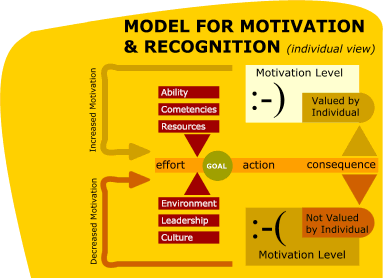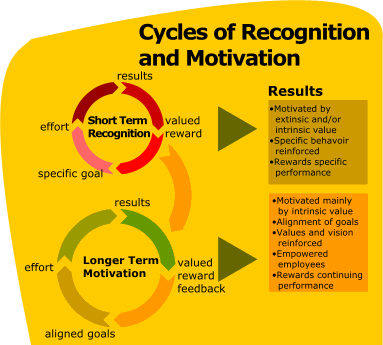

SURVEY QUICK LINKS --> 
FOLLOW US ON 

|
ArticlesMotivating Employees with Recognition StrategiesGOOD INTENTIONS VS. TARGETED RESULTSMany organizations have found creative ways of recognizing and rewarding employees for their efforts and/or contribution to the organization. Unfortunately, many of these methods are based on "good intentions" which reinforce certain behaviors that do not necessarily provide motivation or contribute to organizational success. For Example, Lydia had done a series of evening career training sessions, to accommodate company employees and their spouses, in addition to her usual responsibilities during the day. In recognition for this effort, her manager gave her some tickets to a football playoff game. She was pleased with the recognition, but said; "I appreciate the thought, as these tickets are very valuable, but I really do not enjoy sitting in sub-zero conditions, watching 2 teams chasing a ball around a frozen field. I would have preferred tickets to the ballet, or lunch at the Bistro Cafe!" This is a classic case of Good Intentions, that missed the mark. What could have Lydia's manager done to make the reward have been more motivating? He could have simply asked her, what she would prefer.
According to the model, motivation of individuals can be described in the following terms:
There are also other factors that influence the nature of the actions that an individual takes to achieve a goal include:
All of these are important factors that enable an individual to achieve a goal and can be demotivating if they prevent the individual from successfully completing their task. However, we will focus our attention on the consequences of rewards and recognition in this model. Assuming that the performance goal is clearly understood, providing a reward that is valued by the individual, will increase their motivation, which in turn will result in increased effort and enthusiasm in achieving a specific goal. Provide a reward that is not valued by the individual, and you risk the chance of demotivating the individual which will eventually result in decreased effort and enthusiasm towards achieving a goal. According to Aubrey Daniels, a strong supporter of reinforcement theory: "People do what they do because of what happens to them when they do it!" Rewards and recognition can be used within an organization as a major source of motivation and reinforcement of desirable behavior. To keep the motivation spiral moving in a positive direction, it is important to understand what employees value, or provide choices so that they can choose a reward that is motivating. The concepts of flexible benefits and employee involvement are rooted in this concept. There are numerous types of reward and recognition strategies that generally fall into the following categories:
Examples of simple low-cost recognition strategies that have had effective results, include:
In viewing the wide variety of rewards and recognition strategies available, another observation becomes apparent. There is a difference in the impact of short-term recognition and longer-term motivation strategies. Short-term, immediate approaches are particularly useful, to quickly reinforce specific behavior. But to motivate in the longer-term, the goals of the individual and the organization must be closely aligned, and the behavior that is rewarded must be consistent with the achievement of these goals. Longer-term strategies tend to motivate primarily through intrinsic means, and support employee empowerment. This is summarized in the model below.
There are certainly major gains to be made through using quick rewards to reinforce behavior, but it must be clear that appropriate behavior is being rewarded. For example, Fred receives an award for completing a project in record time. However, he incurred excessive expenses in the process, which reduced the profit margin to below target, because of the amount of overtime that his team put in to beat the deadline. This is a case of also rewarding behavior that is not aligned with the organizational goals, therefore the message to employees could be that quick completion is important at all costs. This example demonstrates, that effective motivation strategies must be clearly aligned and reinforce organizational goals and values in order to be effective in the longer term. As indicated in the model above, short-term recognition strategies can also be integrated into longer-term strategies through alignment with organizational values and strategic direction. The other critical enabling factor is the involvement of employees in goal setting and reward choices to ensure that the motivation spiral continues to move upwards. In conclusion, from the experience of working with numerous organizations on reward and recognition strategies, the following are guideline that I have found useful:
|
||||||||
|
|||||||||


